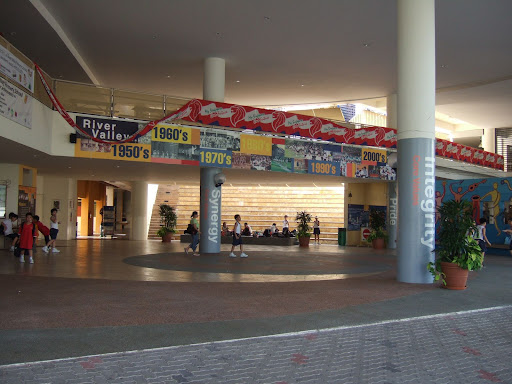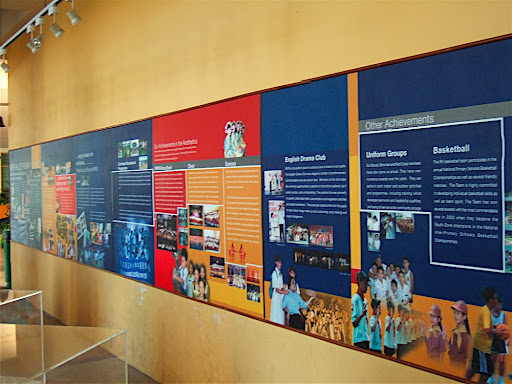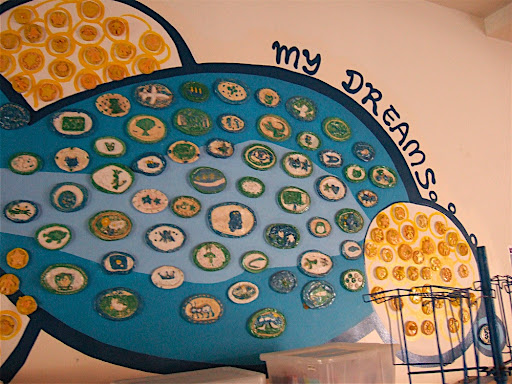 The physical structure of the all the schools is similar, yet intriguing. They are quite mammoth by our standards, but are set up very well. They are both indoors and outdoors and are centered around large courtyards, amphitheaters, and play areas. The classrooms are arranged to get maximum air flow and have numerous powerful fans. They really are quite comfortable especially considering it is quite hot and humid. You don't notice them being outdoors except for the noise coming from the
The physical structure of the all the schools is similar, yet intriguing. They are quite mammoth by our standards, but are set up very well. They are both indoors and outdoors and are centered around large courtyards, amphitheaters, and play areas. The classrooms are arranged to get maximum air flow and have numerous powerful fans. They really are quite comfortable especially considering it is quite hot and humid. You don't notice them being outdoors except for the noise coming from the playgrounds and surrounding areas. There are air conditioned parts such as the office, the teacher work rooms, and the largest gymnasium.
playgrounds and surrounding areas. There are air conditioned parts such as the office, the teacher work rooms, and the largest gymnasium.
When entering a school, they all have guard gates with usually two attendants. They assist you in finding the office and checking in. The staff are very professional and courteous. Immediately upon entering, there are usually core values that the school has adopted prominently displayed around. These can include honesty, respect, risk, integrity, synergy, leadership, etc. These really come into play for the entire community. These are integral to the school and the classes then create classroom rules that uphold these big core values. They show up again in the hallways, other rooms, etc. There is student work all around, but it tends to be in banners or framed art pieces rather than bulletin boards.
The classrooms have quite a few desks in them as the class size is 40-43 for the A, B, and C classes, but it reduces to 30 - 33 for the "average" classes. The children stay in the room and the teachers switch. P1 and P2 have the same teacher all day, but they start departmentalization around P3. The exact logistics appear to depend upon the team and teachers, etc. They certainly do not have the classroom resources that we take for granted. The rooms are very tidy and the kids are in charge of keeping track of all the materials and stacks of papers since the teachers move in and out.
Since the teachers may not be stationed in one classroom, they have what they call a staff room. It looks like a typical cubicle office. They wouldn't let us take pictures because they were worried that it was too messy. PLEASE! (there was definite clutter, but you could tell folks were working). It seems to be really good for collaboration and for sharing resources. Being in such close proximity would really improve our teamwork so you didn't have to hunt somebody down.
The kids have a lot more physical freedom in the schools than we are used to seeing in the US. They can walk from class to recess or lunch by themselves and do quite well. Parenthetically, they get a half hour a day for recess on top of PE. The schools are ranked based not only of academics, but also physical fitness. There were only four restrooms in a school for over 1000 children, but, you know it by now, they were spotless.
There are lots of areas in the school that are green--a garden, a spice garden, and usually some other area. There were big outdoor theaters, play areas, courtyards, and other things. A couple of schools had a climbing wall, one had a museum, they all had art rooms, music roo ms, computer labs, and science labs (all of which they come to with their teachers). They all had counseling rooms and some even had a teacher counselor.
ms, computer labs, and science labs (all of which they come to with their teachers). They all had counseling rooms and some even had a teacher counselor.
The desks are arranged in groups of two or four to promote interaction. We noticed that a lot of the classrooms also have tables outside in the hall. There are usually student groups working at these or peer tutoring going on. The students all seem on task (as much as to be expected) while out there. Cooperation is greatly encouraged.
Each of the schools have very specific uniform requirements. We started to notice that even the socks had the school logo. The students also have paper with the school logo. There are also flags and banners around with the school logo and also Singapore. There is a lot of national pride.
The kids usually arrive at school by 7a. They have silent reading for 15 minutes or a half hour. It is also a time for peer tutoring for those kids tha t are "average" or struggling. The cafeterias look to have 4 or 5 different stalls selling items. There is plenty of choice for the different diet requirements of the students. The school day officially ends at 1:30, but most kids are there until around 4p. That is when tutoring happens, as well as most extracurricular activities. When asked about homework, everybody replied, "a lot." While teachers really try to coordinate, students do have a big workload at home. (that is also the only discipline problem mentioned, but we'll post about that a different time. . .)
t are "average" or struggling. The cafeterias look to have 4 or 5 different stalls selling items. There is plenty of choice for the different diet requirements of the students. The school day officially ends at 1:30, but most kids are there until around 4p. That is when tutoring happens, as well as most extracurricular activities. When asked about homework, everybody replied, "a lot." While teachers really try to coordinate, students do have a big workload at home. (that is also the only discipline problem mentioned, but we'll post about that a different time. . .)
We didn't tour any, but we saw (walking around, on the train, and on the bus) a TON of International Schools as well as "mega" high schools. These were absolutely humongous and seemed more like community colleges. We also noticed that there were kids in school uniforms each day of the week. Even if school was not in session, they were involved in activities. See more school pictures.
-Marie
View Post
We learned a lot about math in Singapore and we have a lot to share. Teachers make a bigger difference than books or buildings, and teachers are big part of Singapore's success. The teachers in Singapore are very well trained and prepared to teach. They are expected to complete 100 hours of professional development compared to 40 hours for Texas teachers. All teachers, even for the youngest grades, have many more hours of college credit for math. US education degrees are usually pretty light on the math requirement.